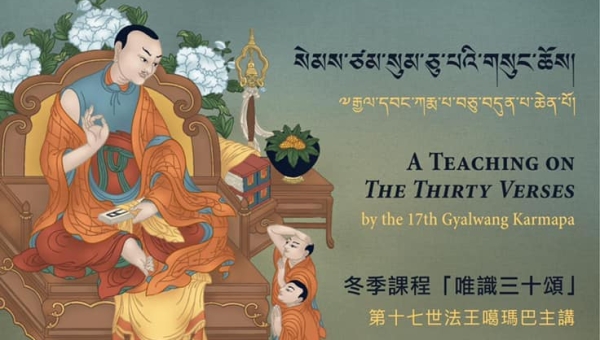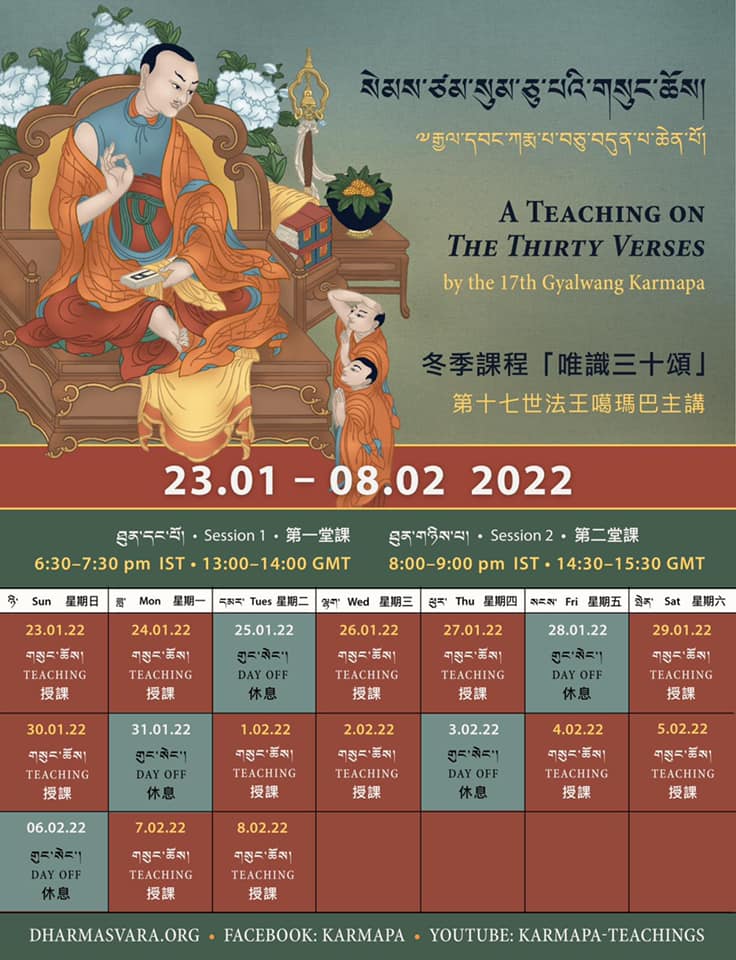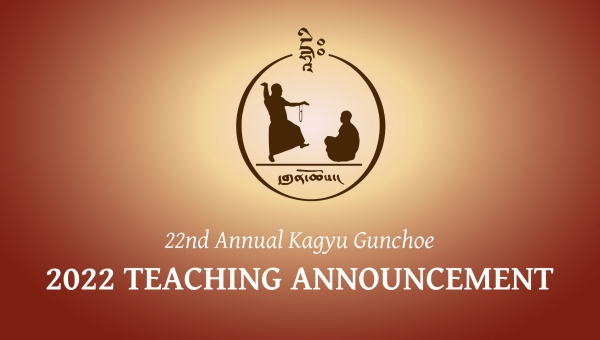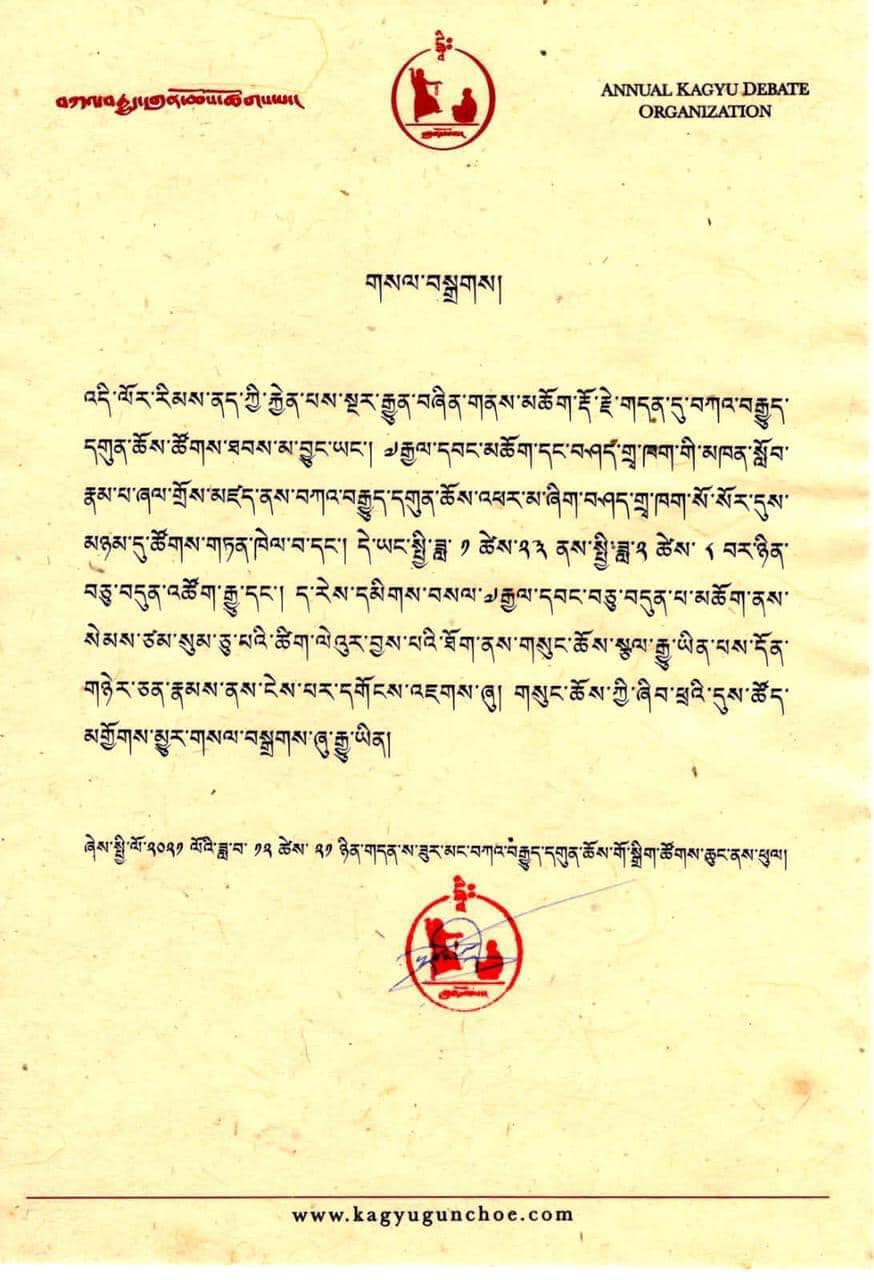Day 1: The Rise and Fall of the Mind Only School and Why It Deserves Our Respect and Study
A Teaching on Vasubandhu’s The Thirty Verses
Day 1: The Rise and Fall of the Mind Only School and Why It Deserves Our Respect and Study
23 January 2022
His Holiness The Gyalwang Karmapa Ogyen Trinley Dorje opened the teachings on Vasubandhu’s Thirty Verses by greeting everyone. While the Kagyu Gunchö Winter Teachings in Bodhgaya were cancelled due to the pandemic, shedras held their own events and requested that His Holiness teach via webcast. Karmapa had chosen Mind Only since it is a philosophical topic appropriate for shedra students. It is also a “big blank” for most Tibetan Buddhists.
During the first half of the Sunday teaching, Karmapa laid out the reasons why Tibetan Buddhists should learn more about the Mind Only school, which holds that everything that appears is a perception in our mind. While that way of thinking runs counter to the materialist view dominant in contemporary society, Mind Only offers the potential to transform our relationship to ourselves and each other.
Mind Only is one of four major Buddhist philosophical schools: The Great Exposition [Vaibhāśika]and Sutra [Sautrantika] Schools of the Foundation Vehicle, and the Middle Way [Madhyamaka] and Mind Only [Cittamatra] Schools of the Mahayana Vehicle. Of the four, The Mind Only School is not well understood by Tibetan Buddhists, and its ideas and traditions are preserved in a great body of work that exists in China and Japanese texts. “If you want to understand the philosophy of the listeners, then you absolutely must know the Great Exposition and Sutra schools,” said Karmapa, “and if you want to know Mahayana philosophy, you absolutely must understand the Middle Way and Mind Only.”
Because Karmapa had the opportunity to study other languages, he has been able to dive into the ocean of knowledge that is the Chinese Buddhist canon and read articles by international Asian and Western scholars. This study has increased his knowledge, opened his eyes, and proven very beneficial. “I see that contemporary research is very important for us Tibetan Buddhists, and in that respect, we have been left far behind. I thought that if I were able to tell you what I have learned, it might be beneficial. This has been my hope. This is what gives me the courage to speak about this.”
The Importance of the Mind Only School
Karmapa began by placing the Mind Only school in a historical context. It was not the earliest Mahayana school; that was Madhyamaka or Middle Way, founded by the Indian Buddhist philosopher Nagarjuna in the 2nd century CE with the text Root Verses of the Middle Way. A few centuries later, Asanga and his disciples, dissatisfied with aspects of Middle Way philosophy, began to question the way things appear to us. Using reasoning and logic, they proved that what appears to us are confused perceptions. By investigating the workings of the mind in great detail, Asanga developed the framework of the eight consciousnesses: the sense consciousnesses, the mental consciousnesses and the alaya or ground consciousness.
While contemporary society dismisses the idea that nothing exists outside of mind, the Mind Only school was widespread and highly successful - larger even than the Middle Way. According to Feast for Scholars, a history of Buddhism written by reincarnate lama Pawo Tsuglak Trengwa in the 16th century, Chandrakirti was the only Middle Way scholar at Nalanda University when he was there in the 7th century; all the others were Mind Only. When Bhavaviveka (6th century) and Chandrakirti argued for the Middle Way, their main opponent was the Mind Only. Their refutations of other Buddhist schools are no more than a few stanzas.
Other evidence of the influence of Mind Only comes from Shantarakshita, the 8th century Indian scholar and abbot of Nalanda who explained the ultimate truth according to the Middle Way and the relative truth according to Mind Only.
The ultimate view of Secret Mantra is mostly the Middle Way, but scholars have described the influence that Mind Only philosophy had on the Yoga tantra. Thus gaining a good understanding of the Mind Only view is extremely important not only for understanding sutras but for understanding Buddhist tantra.
Given the power and influence of the Mind Only school, how did ideas about the primary role of mind decline to the point where they have become almost laughable? Karmapa traced it back to the rise of materialist philosophy in the Renaissance, a time of great intellectual developments in Europe. Released from the confines of medieval philosophy and belief systems, people began to believe that we are separate from nature and could therefore impose our will upon it. The natural sciences developed very quickly, with the aim of controlling nature, and a materialist view came to dominate, which has led to environmental destruction, air pollution and many other dangers that threaten humanity and Earth’s living creatures.
How Can Mind Only Concepts Benefit Humanity?
In the Mind Only view, humans and the natural environment are not in any way in opposition to each other. In fact, the natural world is created by our own mind, so nature is a part of ourselves. In contemporary times, however, we study science from a young age, creating a strong imprint of the materialist view. “Of course we think it is true. We never even begin to question or to doubt it,” Karmapa said. And yet we live with the damage it has wrought, in our environment and in our minds.
We live in the Age of Technology and Information, with incessant demands. “It’s like a kettle of boiling water on a stove,” Karmapa said. “It doesn’t stop for even an instant. We get tired but the technology never does.” He also compared human beings to puppets whose limbs move up and down, but who aren’t in control of what they do. They are controlled by external forces. Even when we focus our minds, we direct them outward at external objects and other people. “We are losing track of our own mind and no longer recognize who we are,” he said. We are separated from the natural world, from our families, from ourselves, and this feeling of alienation leads to mental illnesses. We can seek medical relief, but we must also make efforts on our own behalf, to find out what works and what doesn’t.
Contemporary society has wrong ideas of good and bad and wrong beliefs about what should be done and what should not be done, Karmapa said, and studying Mind Only can help us turn inward and change our ways of thinking. “We will be able to completely cleanse our ideas about the world, our ideas of value, and develop a new way of thinking that accords with the true dharma,” he said.
The Mind Only school arose from an investigation into the world of our human mind, examining in great detail the nature and capacities of the human mind. It gave a fine analysis of the presence of the ground consciousness and afflicted mind and of how the various consciousnesses exist in a mutual relation of cause and effect, each exerting an influence on the others. Mind Only is a complete system of psychology that is the equal of Western psychology, the Karmapa maintained. It is also a religion with curative powers because its aim is to cleanse and correct our polluted and erroneous minds.
“Much of the power or courage we need to survive as a human race comes from things other than science,” Karmapa said. “Mind Only is a Buddhist philosophy and a religion for those who wish to free themselves from suffering, and we are extremely fortunate that such a philosophy has been able to remain continuously to this day.”
The Karmapa pointed out that Middle Way and Mind Only coexisted within the Indian Mahayana Buddhist centers of learning. “The Buddha himself respected the different faculties, capacities, and interests of his students and taught different types of dharma. This then acted as the primary cause and conditions for the different vehicles and philosophies to flourish and improve.”
He encouraged participants to consider their own attitudes toward Mind Only. “In Tibet, we always say the heavens and earth are Middle Way. It is as if we are looking down on the lower philosophies,” Karmapa said. We can appreciate the profundity of the Middle Way, and the broad scope of Mind Only, with its many categories and fine points. “If we understand what the other is like, we can understand clearly what we ourselves are like.”
Who Do We Mean When We Say Mind Only?
After a half-hour break, Karmapa delved more deeply into the originators of the Mind Only school. “We normally take it for granted that the internal mind and external things are separate – that’s how we see it, right? The mind is something that looks out on external things, and the external things appear to us. This is conventional truth, the way we see things in the world. But in 3rd or 4th century India there were some people who had a completely different way of looking at things. They were audacious! They had the courage to think in an entirely different way.” They began to suspect that the way things appear to us are confused perceptions. Using logic and their own meditative experiences, they argued that everything that appears in our perceptions is our own mind. It is not an external entity that is separate from our mind.
The people who explained this were called the Yogachara School or Yogachara Mind Only. Yoga here should be understood to mean dhyana meditation, the practice of resting deeply in the nature of the mind.
However, all Buddhists are concerned with the topic of mind. It is mind that helps us progress along the path from suffering to happiness, and we must focus our awareness one-pointedly on our aim, liberation from suffering. “From a broader understanding, all Buddhists can be said to explain everything as mind only.”
One of the philosophical achievements of Mind Only was to resolve the contradiction between the concepts of selflessness and samsara. If there is no self, what cycles through samsara? The Yogachara answered this by developing the idea of the all-ground or alaya consciousness, which was ultimately the basis for projecting a self and the foundation of samsara. The capacities or seeds for everything to arise is in the all-ground. When causes and conditions come together, they become a mode of appearance as something actual. Their effect or imprints are then stored in the all-ground.
The philosophies of no-self and Mind Only both examine what exists and what does not exist in the ultimate nature. Mind Only also explains that there are not external things - or even the mind. “In terms of the ultimate truth, the mind is also no more than an illusory nature,” said Karmapa. “This is a crucial point of Mind Only philosophy.”
A Brief History of Buddhism
The Karmapa then shifted to the topic of how Buddhism developed into many different schools. About hundred years after the Buddha passed into nirvana, a great dispute about the ten precepts arose between the eastern and western communities of the sangha. The sangha split into two schools, the Sthaviravada which held firmly to traditional views and the Mahasaṃghika, which favored change. This is described as the division into the two root schools.
Around the first century BCE, many different schools developed as subdivisions within the Sthaviravada and Mahasaṃgika with different lineages, different sutras, and different texts on abhidharma. This time is called The Period of the Schools, or the time of the Foundation Vehicle. The two root schools and 18 subdivisions are called the 20 schools of the listeners [Śrāvaka]. The Mahayana called the listener schools Hinayana, but that is a derogatory term and no longer appropriate to use.
The listener schools researched deeply and thoroughly the meaning of the dharma, compiling all the teachings the Buddha gave, dividing them into sections, elaborating fully on the meaning, and writing many different commentaries.
According to some Japanese researchers, the scholars of the period of the schools worked so hard to research the meaning of the scriptures that it was as if they had forgotten that the original root of dharma was to bring benefit to all sentient beings. Around the first century CE, there was a great revolt against the philosophies of the schools as many people wanted to bring other sentient beings onto the path to liberation instead of achieving liberation only for themselves, This was the beginning of the spread of the Mahayana.
The Mahayana can be divided into two groups based on view. Middle Way takes the view of emptiness of the Prajnaparamita Sutras as their basis and accepts Nagarjuna’s Root Verses of the Middle Way as their main text. They primarily teach the view of emptiness, so they are called Proponents of Emptiness or Śūnyatāvādin.
The Mind Only view takes the Sutra Unraveling the Intent as its basis and asserts that all phenomena do not transcend mind, or are different ways that vijñāpti (“mere representations”) appear. Those who hold this view are called Mind Only or Vijñānavāda (“the doctrine of consciousness”). The people who propagated this tradition are called Yogacara or Proponents of Mind Only.
The Chang-era Chinese monk Yìjìng wrote an Account of Buddhism Sent from the South Seas that included his observations about dharma in India at the end of the 7th century: According to Master Yìjìng’s travelogue, Yogacara was often shortened to “yogi,” but this did not indicate the entire meaning and it could be confused with the Hindu yoga school. As a result, later in Japan and China, the Mind Only proponents were generally known by the name Yogacara.
According to the Japanese scholar Kōitsu Yokoyama, the Yogacara view of Mind Only continued the view of emptiness taught in the Prajnaparamita Sutras and asserted that there is a mind, which protects the view of emptiness from falling into the extreme of nihilism. In addition, the framework of Mind Only philosophy preserves completely intact the views of the abhidharma, and they are all made elements of the Mind Only view. Thus, in terms of their scriptural traditions, the Mind Only was the view that achieved the greatest and the highest level of philosophy.



















